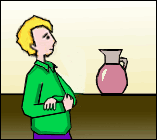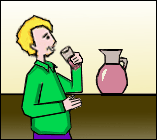|
| |
In order to make a request, we use the て-form of a verb + ください as shown below. ください is a command verb form meaning "give me."
| |
|
|
|
| その |
ボールペン |
を |
みせて |
ください。 |
| Please show me that ball-point pen. |
In general when two (or more) verbs are combined, the Vて form is used for the verb that connects with another verb (e.g., VてV). (Note: と only connects nouns and can NEVER be used to connect verbs as in VとV.) There are separate Vて form formation rules for each
type of verbs.
- The て-form of verbs are formed from the dictionary forms as follows:
The て-form can also be obtained from the Vます forms as follows:
- Drop the ます ending of the nonpast form (e.g., かきます).
This will obtain the verb stem (e.g., かき).
- If the verb stem ends with one of the following on the left,
change it to the ending on the right. (Note that some Vて forms result in the same form: いって ("go") and いって ("say").)
Hint: Some people may feel helpful to memorize this as: くい・ぐい・すし・むん・ぶん・るうつ ("Does this sound like a song?")
- Drop the ます ending of the nonpast form (e.g. たべます).
This will obtain the verb stem (e.g., たべ).
- Add て to the verb stem.
There are two irregular verbs in Japanese (きます
and します), and they conjugate as follows:
The classroom request form Vてください earlier actually
consists of two verbs as shown below. ください is a polite imperative
form of the verb くださいます ("give me"). Vてください literally means "Please give me your V-ing."
| |
| まって |
ください。 |
Please wait. |
| きいて |
ください。 |
Please listen/ask. |
| みて |
ください。 |
Please look at it. |
| いって |
ください。 |
Please say it. |
| だして |
ください。 |
Please turn it in. |
(FYI) Verbs can be combined with Vて forms as shown below:
|
 しちじに おきて あさごはんを たべました。 しちじに おきて あさごはんを たべました。 |
I woke up at seven, and ate breakfast. |
 ハンバーガーを かって きます。 ハンバーガーを かって きます。 |
I will buy a hamburger and come back.
(i.e., "I will go and buy a hamburger.") |
|
 田中さんは
テレビを みて、 田中さんは
テレビを みて、
スミスさんは テニスを しました。 |
Ms. Tanaka watched TV,
and Mr. Smith played tennis. |
|
 あるいて いきます。 あるいて いきます。 |
I will walk, and go. (i.e., "I will go by walking.") |
 コンピュータを つかって かきました。 コンピュータを つかって かきました。 |
I used a computer, and wrote it.
(i.e., "I wrote it by using a computer.") |
 Note
here that て-forms are tenseless. In this case, つかって can
be interpreted as either "use" (present/future) or "used" (past) depending on the tense of the main verb
(last verb). Note
here that て-forms are tenseless. In this case, つかって can
be interpreted as either "use" (present/future) or "used" (past) depending on the tense of the main verb
(last verb).
|
| |
Two similar expressions Nが ございます and Nでございます are
introduced in this lesson. These expressions are the business forms
of Nが あります and Nです, respectively.
| |
| Nが あります |
Nが ございます |
There is/are N. [inanimate] |
| Nです |
Nでございます |
It's N. |
Both Nがあります and Nがございます require that N is an inanimate
object. In contrast, Nです/でございます can be used for both animate
and inanimate objects.
Unlike the honorific verb いらっしゃいます  ("Someone is [here/there]"), でございます is not an
honorific form, so it can be used for in-group people including
the speaker himself/herself. ("Someone is [here/there]"), でございます is not an
honorific form, so it can be used for in-group people including
the speaker himself/herself.
| |
|
かさが あります。
田中さんが います。 |
=
= |
かさが ございます。
田中さんが いらっしゃいます  。 。 |
There are umbrellas.
[inanimate]
Mr. Tanaka is (here/there). [animate] |
田中さんです。
かさです。 |
=
= |
田中さんでございます。
かさでございます。 |
He is Mr. Tanaka.
It's an umbrella. |
Exercise:
Explain why the following expressions are unacceptable? Correct
the errors.
- かさが いらっしゃいます。("There are umbrellas.")
- 田中さんが ございます。("Mr. Tanaka is (here/there).")

Both of the following polite sentences mean "The
stationery department is on the 7th floor." What are the regular
forms of these sentences?
- ぶんぼうぐうりばは 7かいでございます。
- ぶんぼうぐうりばは 7かいに ございます。
 |
| |
 indicates an exceptional pronunciation. indicates an exceptional pronunciation.
|
| |
The following are common expressions to buy something. Note that
the quantity expression (how many or how much you would like to
buy) is placed after the object (X) you buy.
| X を |
Quantity |
Verb |
|
| その とけいを |
|
下さい {ください}。 |
Please give me that watch. |
| その あかいペンを |
五本 |
下さい {ください}。 or
おねがいします。 |
Please give me those five red pens. |
トマトを |
三こ |
下さい {ください}。 |
Please give me three tomatoes . |
Note the similar structures for saying "There are..."
or "I have..." below.
| あおいノ
ートが |
二さつ |
あります。 |
There are two blue notebooks. |
You can combine things you buy in one statement by using the particle と as shown below.
| その あかい ペンを |
五本 |
と |
あおい ノートを |
二さつ |
かいました。 |
 |
+ |
 |
bought |
| I bought those five red pens and two blue notebooks. |
More examples:
| CD |
を |
三まい |
かいました。 |
| じしょ |
が |
四さつ |
あります。 |
| ほん |
を |
二十四さつ |
よみました。 |
| オレンジ |
を |
十{とお} |
ください。 |
| ねこ |
が |
十五ひき |
ここに います。 |
| メロン |
を |
六こ |
いれて ください。 ("Put in six melons.") |
| カプセル |
を |
三つ |
のんで ください。("Take three capsules.") |
| かさ |
を |
何本 {なんぼん} |
もっていますか。 ("Do you have?")  |
| オレンジ |
を |
何こ {なんこ} |
たべましたか。 |
| けしゴム |
が |
いくつ |
ありますか。 |
 This can be: 何本 かさを もっていますか。 This can be: 何本 かさを もっていますか。
 This can be: 何こ オレンジを たべましたか。 This can be: 何こ オレンジを たべましたか。
 This can be: いくつ けしゴムが ありますか。 This can be: いくつ けしゴムが ありますか。
Location expressions can involve quantity expressions.
| レストラン |
は |
ちか一かい |
に |
あります。 |
| かぐうりば |
は |
何かい (=どこ) |
に |
ありますか。 |
| ぶんぼうぐ |
は |
何かい (=どこ) |
で |
かいますか。 |
 This can be: 何かい (=どこ) に かぐうりばが ありますか。 This can be: 何かい (=どこ) に かぐうりばが ありますか。
 This can be: 何か い(=どこ) で ぶんぼうぐを かいますか。 This can be: 何か い(=どこ) で ぶんぼうぐを かいますか。
When the objects being referred to are understood, you can drop
the object names without confusion.
| 五本 |
下 {くだ} さい。 |
Please give me five (of those long things). |
| 四さつ |
かいました。 |
I bought four (books, magazines, etc.). |
| 250こ |
つくりました。 |
I made 250 (small, solid things). |
| 5300まい |
あります。 |
I have 5300 (sheets of paper, etc.). |
| 三つ |
です。 |
(He/She) is three (years old).
(or "They are three [things].") |
|
| |
The verb なります
means "become" or "come (out) to be." The expression /Noun + に + なります/ expresses change of states. It means "[Something/Someone] becomes/comes out to be N."
For example, if the number of cats increases from one cat to three cats, you can say さんびき に なりました. If the price of a book changes to 2700 yen, you can say 2700円になりました.
| |
|
| ねこは |
3びき |
に |
なりました。 |
テレビは |
しずか |
に |
なりました。 |
    
1 cat 3 cats |
   |
| その本は |
2700円 |
に |
なりました。 |
あの人は |
ゆうめい |
に |
なりました。 |
  
2500円 2700円 |
   |
When the change is due after you have given the store clerk some money, you will often hear the following expression ("The change comes out to be ..."). This is also a change of states expression.
| 53円の おかえしに なります。 |
The change comes out to be 53 yen.
(Lit. "It comes out to be the change of 53 yen.") |
The verb なります can also be used to describe more generic sense of "become
N" as shown below.
| 田中さんは 大学をでて、先生に なりました。 |
| Mr. Tanaka graduated from college and became a teacher. |
|
| |
The second type of change of states involves /Plain-Form Verb + ように + なります/. It means "[Something/Someone] comes to a habitual state of V-ing."
For example, someone who studies Japanese eventually comes to understand Japanese. That is, the state of "not understanding Japanese" changes to a habitual state of "understanding Japanese."
| 日本ごが |
わかる |
ように |
なりました。 |
(Someone) comes to understand Japanese. |
| うちで |
べんきょうする |
ように |
なりました。 |
(Someone) comes to study habitually at home. |
| ひとりで |
あそぶ |
ように |
なりました。 |
(Someone) comes to play habitually at home alone. |
| ワインを |
のむ |
ように |
なりました。 |
(Someone) comes to drink wine habitually. |
   |
|
| |
So far, we learned to count up to 99. The following is how to count beyond 100 by the 100 (= ひゃく), 1,000 (= せん) and 10,000 (= まん).  Note that for 100 and 1000, いち is not said. Large numbers are simply pronounced without anything in between: 8,345 = はっせん さんびゃく よんじゅう ご. Note that for 100 and 1000, いち is not said. Large numbers are simply pronounced without anything in between: 8,345 = はっせん さんびゃく よんじゅう ご.  indicates exceptional pronunciation. indicates exceptional pronunciation.
100 |
百 |
ひゃく |
1,000 |
千 |
 せん せん |
10,000 |
一万 |
いちまん |
200 |
二百 |
にひゃく |
2,000 |
二千 |
にせん |
20,000 |
二万 |
にまん |
300 |
三百 |
さんびゃく |
3,000 |
三千 |
さんぜん |
30,000 |
三万 |
さんまん |
400 |
四百 |
よんひゃく |
4,000 |
四千 |
よんせん |
40,000 |
四万 |
よんまん |
500 |
五百 |
ごひゃく |
5,000 |
五千 |
ごせん |
50,000 |
五万 |
ごまん |
600 |
六百 |
ろっぴゃく |
6,000 |
六千 |
ろくせん |
60,000 |
六万 |
ろくまん |
700 |
七百 |
ななひゃく |
7,000 |
七千 |
ななせん |
70,000 |
七万 |
ななまん |
800 |
八百 |
はっぴゃく |
8,000 |
八千 |
はっせん |
80,000 |
八万 |
はちまん |
900 |
九百 |
きゅうひゃく |
9,000 |
九千 |
きゅうせん |
90,000 |
九万 |
きゅうまん |
How many
100s? |
何百 |
なんびゃく |
How many
1,000s? |
何千 |
なんぜん |
How many
10,000s? |
何万 |
なんまん |
The following are the numbers up to one hundred million. To read large numbers, the Western system segments them in groups of 3 digits:
XXX, XXX, etc. In Japanese, it is easier to read large numbers if you segment them in groups of 4 digits: XXXX, XXXX, etc. as shown below. Unfortunately, as the Western system of segmenting large numbers has been
adopted in Japan, the close connection between mathematical and
linguistic expressions has been lost.
| Western system |
|
Japanese system (old) |
1,000 |
one thousand |
= |
1000 |
千 |
せん |
10,000 |
ten thousand |
= |
1,0000 |
一万 |
いち まん |
100,000 |
one hundred thousand |
= |
10,0000 |
十万 |
じゅう まん |
1,000,000 |
one million |
= |
100,0000 |
百万 |
ひゃく まん |
10,000,000 |
ten million |
= |
1000,0000 |
一千万 |
いっせん まん |
100,000,000 |
one hundred million |
= |
1,0000,0000 |
一おく |
いち おく |
100,000
(=10,0000) |
じゅうまん |
十万 |
1,000,000
(=100,0000) |
ひゃくまん |
百万 |
200,000
(=20,0000) |
にじゅうまん |
二十万 |
2,000,000
(=200,0000) |
にひゃくまん |
二百万 |
300,000
(=30,0000) |
さんじゅうまん |
三十万 |
3,000,000
(=300,0000) |
さんびゃくまん |
三百万 |
400,000
(=40,0000) |
よんじゅうまん |
四十万 |
4,000,000
(=400,0000) |
よんひゃくまん |
四百万 |
500,000
(=50,0000) |
ごじゅうまん |
五十万 |
5,000,000
(=500,0000) |
ごひゃくまん |
五百万 |
600,000
(=60,0000) |
ろくじゅうまん |
六十万 |
6,000,000
(=600,0000) |
ろっぴゃくまん |
六百万 |
700,000
(=70,0000) |
ななじゅうまん |
七十万 |
7,000,000
(=700,0000) |
ななひゃくまん |
七百万 |
800,000
(=80,0000) |
はちじゅうまん |
八十万 |
8,000,000
(=800,0000) |
はっぴゃくまん |
八百万 |
900,000
(=90,0000) |
きゅうじゅうまん |
九十万 |
9,000,000
(=900,0000) |
きゅうひゃくまん |
九百万 |
Additional examples follow.
- 193 = 百九十三 {ひゃく きゅう じゅう さん}
- 365 = 三百六十五 {さん びゃく ろく じゅう ご}
- 1,234 = 千二百三十四 {せん にひゃく さんじゅう よん}
- 100+200=300 {ひゃく たす にひゃくは さんびゃく}
Reading tip = Regroup the number in 4 digits and read the comma (,) as まん.
- 89,473 → 8,9473 → はちまん きゅうせん よんひゃく ななじゅう さん
- 750,241 → 75,0241 → ななじゅう ごまん にひゃく よんじゅう いち
- 1,672,500 → 167,2500 → ひゃくろくじゅうななまん にせんごひゃく
|
| |
The monetary unit in Japan is えん{円}.  4 yen is よえん, not よんえん. 4 yen is よえん, not よんえん.  are also exceptions in pronunciation. are also exceptions in pronunciation.
| 1 yen |
一円 |
いちえん |
1 dollar |
いちドル |
1 cent |
いっセント |
| 2 yen |
二円 |
にえん |
2 dollars |
にドル |
2 cents |
にセント |
| 3 yen |
三円 |
さんえん |
3 dollars |
さんドル |
3 cents |
さんセント |
| 4 yen |
四円 |
よえん |
4 dollars |
よんドル |
4 cents |
よんセント |
| 5 yen |
五円 |
ごえん |
5 dollars |
ごドル |
5 cents |
ごセント |
| 6 yen |
六円 |
ろくえん |
6 dollars |
ろくドル |
6 cents |
ろくセント |
| 7 yen |
七円 |
ななえん |
7 dollars |
ななドル |
7 cents |
ななセント |
| 8 yen |
八円 |
はちえん |
8 dollars |
はちドル |
8 cents |
はっセント |
| 9 yen |
九円 |
きゅうえん |
9 dollars |
きゅうドル |
9 cents |
きゅうセント |
| 10 yen |
十円 |
じゅうえん |
10 dollars |
じゅうドル |
10 cents |
じゅっセント |
How much?
or
How many yen? |
何円 |
いくら
or
なんえん |
How many
dollars? |
何{なん}ドル
|
How many
cents? |
何{なん}セント |
To state how much something costs per unit, we use the following
type of noun sentences.
| |
| Q: |
その とけいは |
|
いくら |
ですか。 |
| |
How much is that watch? |
| A: |
|
|
六千八百円
{ろくせんはっぴゃくえん} |
です。 |
| |
It's 6,800 yen. |
| Q: |
ガソリンは |
1ガロン |
何ドル{なんドル} |
ですか。 |
| |
How many dollars is a gallon of gasoline? |
| A: |
|
|
4ドル8セント |
です。 |
| |
(Gasoline) is one dollar $4.08 (a gallon). |
Be careful with the placement of quantity expressions. They come after (not before) the unit expression.
|
 |
| |
We learned とても ("very...") modifies adjectives before. Another adverbial expression もうすこし ("a little more") and もっと ("more") can also modify adjectives. もうすこし and もっと can modify verbs directly as shown below, while とても cannot modify verbs directly.
| |
|
| |
もうすこし
|
まってください。 |
Please wait for a little while. |
| これより |
もっと |
やすいのが ありますか。 |
Do you have a cheaper one than this? |
| とても works only with adjectives. |
| |
|
| |
とても |
しずかですね。 |
It's very quiet. |
| The following does not work. |
 |
とても |
べんきょうします。 |
[Ungrammatical] |
|
 |
| |
The third type of change-of-state expression involves い-adjectives + く + なります. The い-adjective must be changed to the く-form by removing the い ending and adding く instead (e.g., あたらしい → あたらしく).  Note the exception: The く-form of いい is よく. The equivalent English expressions may require comparative forms of adjectives: good/well → better, big → bigger, etc. Note the exception: The く-form of いい is よく. The equivalent English expressions may require comparative forms of adjectives: good/well → better, big → bigger, etc.
More examples:
- クラスが おもしろく なりました。 The class has become more interesting.
- しごとが いそがしく なりました。 The job has become busier.
- へやが せまく なりました。 My room has become more cramped.
- もうすこし やすく なりませんか。 Won't it become a little cheaper?

 Culture Note: The Japanese usually don't haggle over princes at stores. This expression is probably limited to informal sales situations such as garage sales where prices are not firmly set. Culture Note: The Japanese usually don't haggle over princes at stores. This expression is probably limited to informal sales situations such as garage sales where prices are not firmly set.
Since plain negative verb forms conjugate like い-adjectives, negative verbs work like い-adjectives (Vない → Vなく なる). That is, something or someone comes to a habitual state of NOT V-ing or stops the habit of V-ing.
| 日本ごが |
わから |
なく |
なりました。 |
(Someone) comes to a habitual state of
NOT understanding Japanese. |
| うちで |
べんきょうし |
なく |
なりました。 |
(Someone) comes to a habitual state of
NOT sutdying at home. |
| ひとりで |
あそば |
なく |
なりました。 |
(Someone) comes to a habitual state of
NOT playing at home alone. |
| ワインを |
のま |
なく |
なりました。 |
(Someone) comes to a habitual state of
NOT drinking wine. |
|
 Abbreviating verbal expressions using ~です Abbreviating verbal expressions using ~です |
| |
The dialogue shows the clerk's statement 4800円の おかえしでございます at the end. We can consider this statement is the short-hand expression of 4800円の おかえしに なります by replacing になります with でございます.
4800円のおかえし に なります → でございます。
です (or its polite equivalent でございます) can be used to substitute the verb used in the immediately preceding part of the conversation. Some particles used with the verb are also replaced by です.
- Particles often deleted along with the verb: が、で、を、に
- Particles that are not usually deleted: から、まで、と
| 1. |
A: あした なんじに おきますか。
B: 9じ に おきます です。 |
| 2. |
A: どこで ひるごはんを たべましたか。
B: しょくどう で たべました です。 |
| 3. |
A: つくえの 下に なにが ありますか。
B: かばん が あります です。 |
| 4. |
A: アリスさんは どこから きましたか。
B: シカゴから きました です。 |
 When abbreviating, you do not need to use the past tense as in シカゴからでした. When abbreviating, you do not need to use the past tense as in シカゴからでした.
Do not over-use this phrase! This may appear impolite if you use it for every question asking for
information! |
|
|